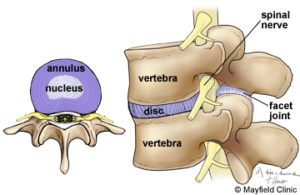Dealing with discs (Part 1)
Your back consists of stacked bones called vertebrae. There are discs between the vertebrae that act as shock absorbers and that allow the spine to bend. Each disc consists of a soft semi-fluid center (the nucleus) that is surrounded and held together by strong ligaments.
The discs in your spine can be the source of a great deal of back pain. This pain can range from a nagging ache and sciatic discomfort to excruciating pain that incapacitates you. There are simple measures you can take to reduce the risk of disc problems occurring and to reduce your pain once problems do occur.
To understand how disc pain happens, it is important to understand normal posture. When standing upright there is a natural inward curve in the lower back called a lumbar lordosis. With this natural lordosis, your body weight is distributed evenly over the discs.
The lordosis is lost whenever you slouch or bend forward. Back problems develop if you find yourself in these positions for long periods of time. This occurs because the vertebrae are placed in a position that pushes the nucleus
The disc, which sits between two vertebrae, acts like a shock absorber for the spine. Nerves come out of the spinal cord and pass through small holes behind the disc.
If the pressure on the ligaments is severe enough they may become weak and allow the soft inside part of the disc to bulge outward (prolapse) and press on the spinal nerves. This can cause sciatic pain in the buttock or down the leg.
 Be sure to consult your massage therapist whenever you have back pain.
Be sure to consult your massage therapist whenever you have back pain.
See you on the table,
Sam
(Part 2 coming in a few days!)
